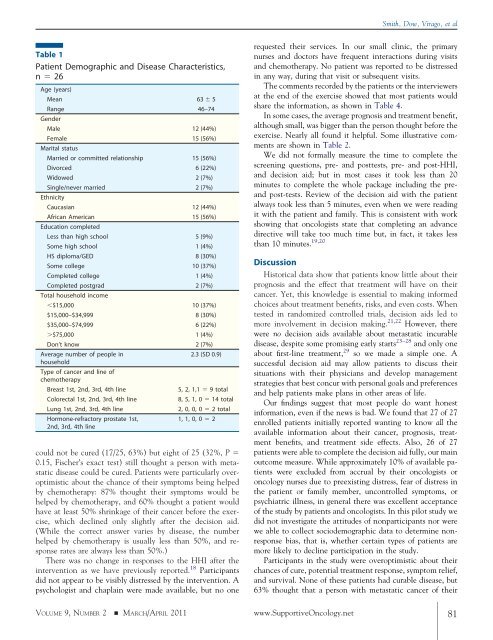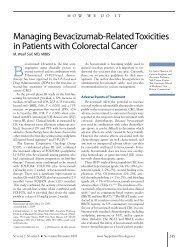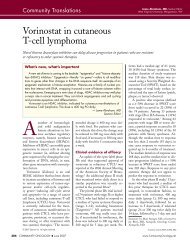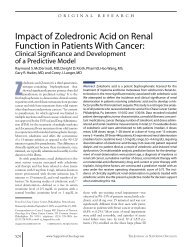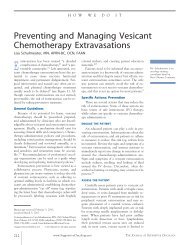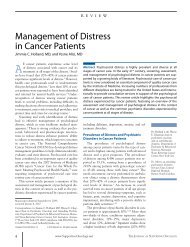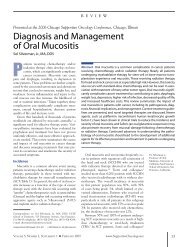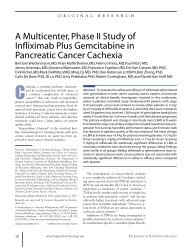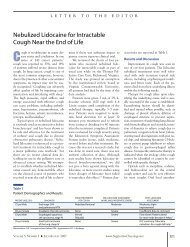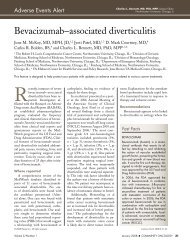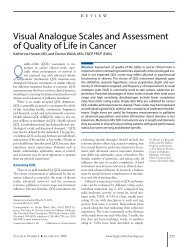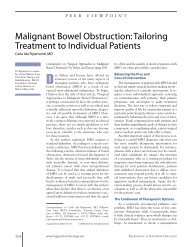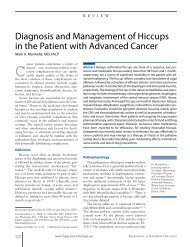Evaluating the “Good Death” Concept from Iranian Bereaved Family
Evaluating the “Good Death” Concept from Iranian Bereaved Family
Evaluating the “Good Death” Concept from Iranian Bereaved Family
Create successful ePaper yourself
Turn your PDF publications into a flip-book with our unique Google optimized e-Paper software.
Table 1<br />
Patient Demographic and Disease Characteristics,<br />
n � 26<br />
Age (years)<br />
Mean 63 � 5<br />
Range<br />
Gender<br />
46–74<br />
Male 12 (44%)<br />
Female<br />
Marital status<br />
15 (56%)<br />
Married or committed relationship 15 (56%)<br />
Divorced 6 (22%)<br />
Widowed 2 (7%)<br />
Single/never married<br />
Ethnicity<br />
2 (7%)<br />
Caucasian 12 (44%)<br />
African American<br />
Education completed<br />
15 (56%)<br />
Less than high school 5 (9%)<br />
Some high school 1 (4%)<br />
HS diploma/GED 8 (30%)<br />
Some college 10 (37%)<br />
Completed college 1 (4%)<br />
Completed postgrad<br />
Total household income<br />
2 (7%)<br />
�$15,000 10 (37%)<br />
$15,000–$34,999 8 (30%)<br />
$35,000–$74,999 6 (22%)<br />
�$75,000 1 (4%)<br />
Don’t know 2 (7%)<br />
Average number of people in<br />
household<br />
Type of cancer and line of<br />
chemo<strong>the</strong>rapy<br />
2.3 (SD 0.9)<br />
Breast 1st, 2nd, 3rd, 4th line 5, 2, 1,1 � 9 total<br />
Colorectal 1st, 2nd, 3rd, 4th line 8, 5, 1, 0 � 14 total<br />
Lung 1st, 2nd, 3rd, 4th line 2, 0, 0, 0 � 2 total<br />
Hormone-refractory prostate 1st,<br />
2nd, 3rd, 4th line<br />
1, 1, 0, 0 � 2<br />
could not be cured (17/25, 63%) but eight of 25 (32%, P �<br />
0.15, Fischer’s exact test) still thought a person with metastatic<br />
disease could be cured. Patients were particularly overoptimistic<br />
about <strong>the</strong> chance of <strong>the</strong>ir symptoms being helped<br />
by chemo<strong>the</strong>rapy: 87% thought <strong>the</strong>ir symptoms would be<br />
helped by chemo<strong>the</strong>rapy, and 60% thought a patient would<br />
have at least 50% shrinkage of <strong>the</strong>ir cancer before <strong>the</strong> exercise,<br />
which declined only slightly after <strong>the</strong> decision aid.<br />
(While <strong>the</strong> correct answer varies by disease, <strong>the</strong> number<br />
helped by chemo<strong>the</strong>rapy is usually less than 50%, and response<br />
rates are always less than 50%.)<br />
There was no change in responses to <strong>the</strong> HHI after <strong>the</strong><br />
intervention as we have previously reported. 18 Participants<br />
did not appear to be visibly distressed by <strong>the</strong> intervention. A<br />
psychologist and chaplain were made available, but no one<br />
Smith, Dow, Virago, et al<br />
requested <strong>the</strong>ir services. In our small clinic, <strong>the</strong> primary<br />
nurses and doctors have frequent interactions during visits<br />
and chemo<strong>the</strong>rapy. No patient was reported to be distressed<br />
in any way, during that visit or subsequent visits.<br />
The comments recorded by <strong>the</strong> patients or <strong>the</strong> interviewers<br />
at <strong>the</strong> end of <strong>the</strong> exercise showed that most patients would<br />
share <strong>the</strong> information, as shown in Table 4.<br />
In some cases, <strong>the</strong> average prognosis and treatment benefit,<br />
although small, was bigger than <strong>the</strong> person thought before <strong>the</strong><br />
exercise. Nearly all found it helpful. Some illustrative comments<br />
are shown in Table 2.<br />
We did not formally measure <strong>the</strong> time to complete <strong>the</strong><br />
screening questions, pre- and posttests, pre- and post-HHI,<br />
and decision aid; but in most cases it took less than 20<br />
minutes to complete <strong>the</strong> whole package including <strong>the</strong> preand<br />
post-tests. Review of <strong>the</strong> decision aid with <strong>the</strong> patient<br />
always took less than 5 minutes, even when we were reading<br />
it with <strong>the</strong> patient and family. This is consistent with work<br />
showing that oncologists state that completing an advance<br />
directive will take too much time but, in fact, it takes less<br />
than 10 minutes. 19,20<br />
Discussion<br />
Historical data show that patients know little about <strong>the</strong>ir<br />
prognosis and <strong>the</strong> effect that treatment will have on <strong>the</strong>ir<br />
cancer. Yet, this knowledge is essential to making informed<br />
choices about treatment benefits, risks, and even costs. When<br />
tested in randomized controlled trials, decision aids led to<br />
more involvement in decision making. 21,22 However, <strong>the</strong>re<br />
were no decision aids available about metastatic incurable<br />
disease, despite some promising early starts 23–28 and only one<br />
about first-line treatment, 29 so we made a simple one. A<br />
successful decision aid may allow patients to discuss <strong>the</strong>ir<br />
situations with <strong>the</strong>ir physicians and develop management<br />
strategies that best concur with personal goals and preferences<br />
and help patients make plans in o<strong>the</strong>r areas of life.<br />
Our findings suggest that most people do want honest<br />
information, even if <strong>the</strong> news is bad. We found that 27 of 27<br />
enrolled patients initially reported wanting to know all <strong>the</strong><br />
available information about <strong>the</strong>ir cancer, prognosis, treatment<br />
benefits, and treatment side effects. Also, 26 of 27<br />
patients were able to complete <strong>the</strong> decision aid fully, our main<br />
outcome measure. While approximately 10% of available patients<br />
were excluded <strong>from</strong> accrual by <strong>the</strong>ir oncologists or<br />
oncology nurses due to preexisting distress, fear of distress in<br />
<strong>the</strong> patient or family member, uncontrolled symptoms, or<br />
psychiatric illness, in general <strong>the</strong>re was excellent acceptance<br />
of <strong>the</strong> study by patients and oncologists. In this pilot study we<br />
did not investigate <strong>the</strong> attitudes of nonparticipants nor were<br />
we able to collect sociodemographic data to determine nonresponse<br />
bias, that is, whe<strong>the</strong>r certain types of patients are<br />
more likely to decline participation in <strong>the</strong> study.<br />
Participants in <strong>the</strong> study were overoptimistic about <strong>the</strong>ir<br />
chances of cure, potential treatment response, symptom relief,<br />
and survival. None of <strong>the</strong>se patients had curable disease, but<br />
63% thought that a person with metastatic cancer of <strong>the</strong>ir<br />
VOLUME 9, NUMBER 2 � MARCH/APRIL 2011 www.SupportiveOncology.net 81


